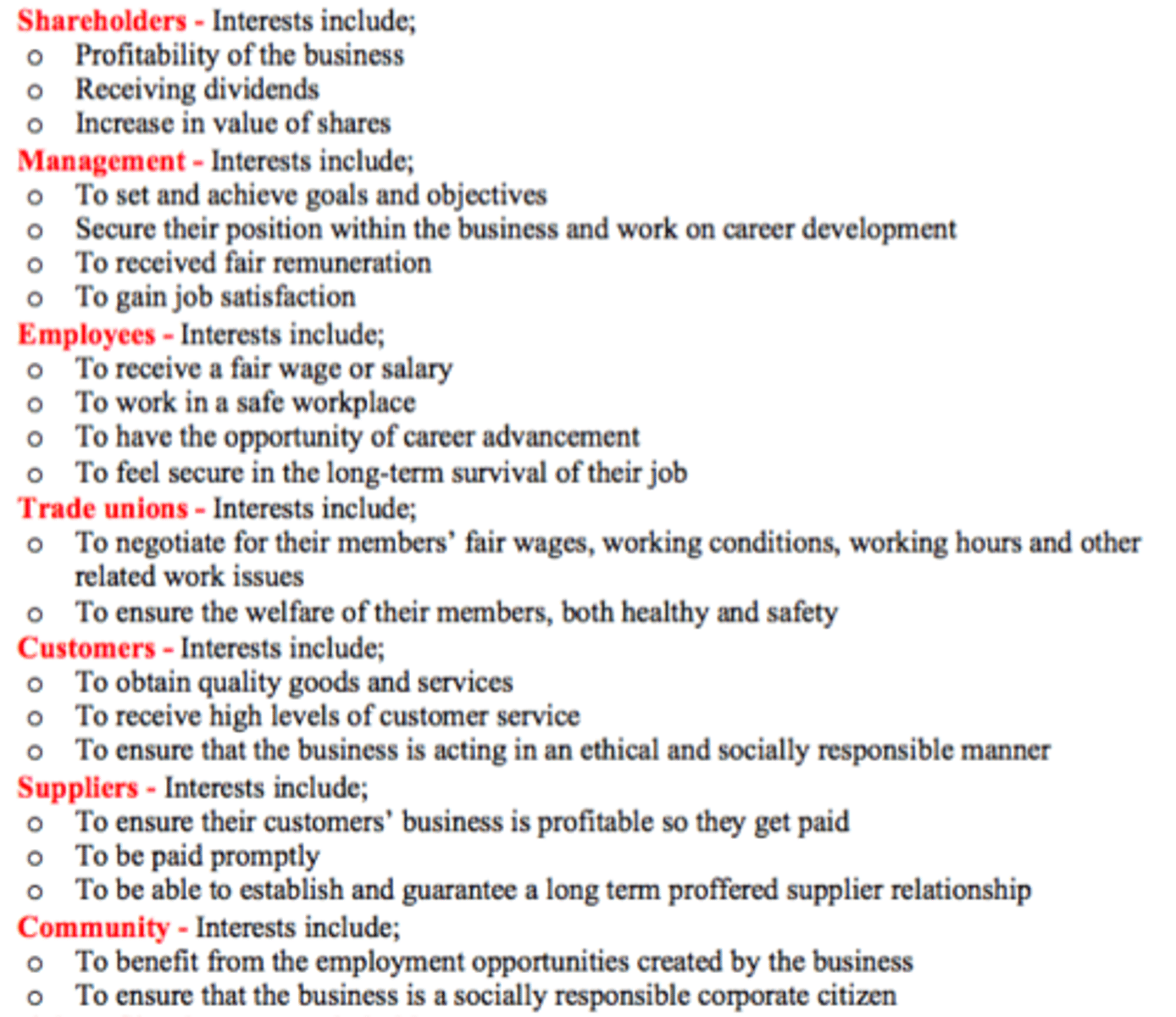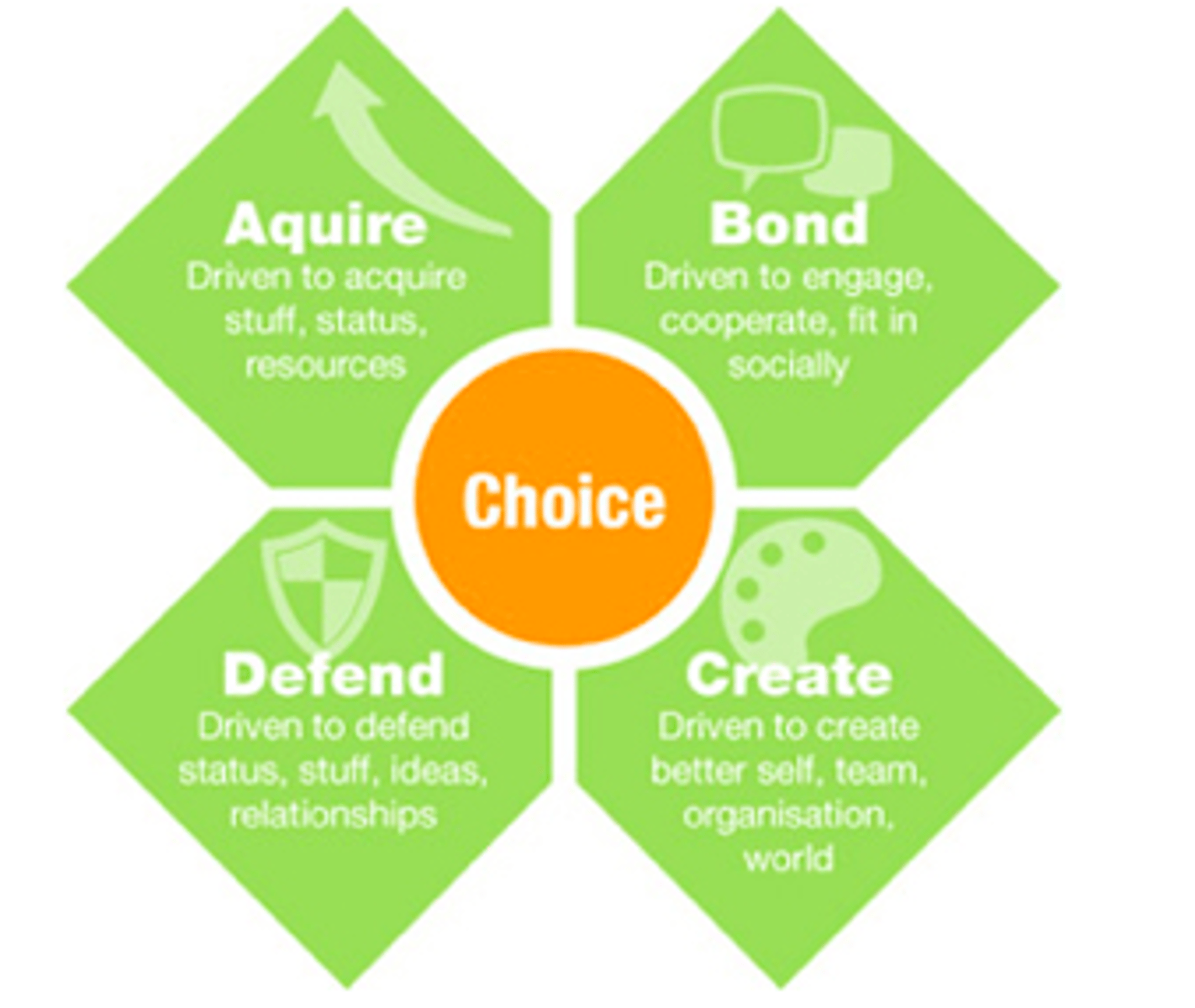VCE Business Management Unit 3 & 4 Exam Revision
1/147
There's no tags or description
Looks like no tags are added yet.
Name | Mastery | Learn | Test | Matching | Spaced |
|---|
No study sessions yet.
148 Terms
What is a business?
A lawful organisation involved in the provision of goods and/or services to consumers to earn a profit.
business type - sole trader
The individual owner of a business who is entitled to keeping all profits, as they are legally and financially responsible for all aspects of the business but are liable for all losses.
- Owner has full control of assets and business decisions
- Simplest and most inexpensive form of business structure, as it only involves a single operator
who does all planning, organising, leading and controlling.
- Liable for all losses of the business, being that they are totally responsible if the business incurs
losses or debts (this is known as unlimited liability).

business type - partnership
A legal form of business ownership where 2 to 20 run the business and distribute income or losses between themselves.
- A partnership combines the expertise and resources of up to 20 people, who all share control of the business
- All partners are jointly liable for business debts (unlimited liability)
- The two types of business partnerships are; general partnerships - where all partners are equally responsible for the business, and limited partnership - where liability of one or more partners is limited, based on the amount they invested into the business

business type - company
A separate legal entity that is owned by shareholders who have limited liability to the value of their shareholding. Run by directors and has perpetual succession (ongoing life). A company has a more complex structure; therefore, it is more expensive to establish than other business structures.
- Companies are incorporated meaning that the business has its own legal identity. This means the business can incur debt, sue and be sued, have shareholders, and must keep financial records.
- There are two types of companies; private limited or public

business type - public listed company
A corporation whose ownership is dispersed amongst whoever wishes to be a part of it within the general public, through the sales of stocks on the stock market. There are is no limit restricting the number of shareholders a public listed company can have.
- Recognised by the word limited (Ltd) after their name, which shows that they offer limited liability to their shareholders.
- Once listed on the Australian Securities Exchange (ASX) the shares in the company can openly be traded with the price of the shares being dependent upon the value perceived by the marketplace
business type - private limited company
The most common type of company in Australia. Private limited companies, recognised by the 'Pty Ltd' (propriety limited) on the end of the name, are companies that you cannot buy shares in on the stock market.
- Has a minimum of 2 and a maximum of 50 shareholders, as shares can only be traded with permission.
- Gives protection to a business by creating a separate legal entity, thus limiting liability (individuals that are part of the company are not responsible for its debts).
- Business operations are owned by the shareholders, yet operated and controlled by directors
business type - social enterprise
A revenue generating business with primarily social objectives whose profits are reinvested for those objectives, rather than being driven by the need to deliver profit to shareholders and owners

business type - government business enterprise
A business that is government owned and operated. They seek to run profitably by controlling costs and selling their goods/services at prices that will cover costs. E.g. Australia Post, NBN, etc. GBEs operate in the public sector (part of the economy owned by the government)

business objectives
Objectives are statements of desired achievement that provide direction for the business. Objectives align with the SMART model (specific, measurable, achievable, realistic, time-bound).
- To make a profit: Most businesses exist to make a profit to increase the financial gains of a business, which can then be distributed to owners or reinvested into the business, so it can improve and grow.
- To increase market share: Market share is the percentage of that total industry sales that a business receives. This links to the objective of wanting to make a profit - if a business can increase the percentage of market share that they possess, it is more likely that they can increase their profit margin.
- To fulfil a market or social need: Social objectives relate to the role of a business in the community. Businesses need to fill a ‘gap in the market’ if they want to be successful, as identifying what your target market is allowing you to meet their needs and build a market for your goods and services
- To meet shareholder expectations: All shareholders expect the business that they have invested in to be successful. They expect the business to make a profit and for any shares purchased to increase in value and dividends to be paid.
vision statement
Outlines an organisation's aspirations in the future.
mission statement
Declaration of the underlying purpose of an organisation's existence and its core values. Doesn't have a time frame and tends to be qualitative rather than quantitative.
stakeholders
anyone with a direct or vested interest in, or impact on the activities of a business, including; shareholders, managers, employees, customers, suppliers, community

potential conflicts between stakeholders - examples
- Employees and management: these stakeholders are likely to clash over the use of profit in the company. Employees will want profit to be used to increase their wage and make their jobs easier (e.g. by increasing training) whereas management will want to either increase their own salaries, or otherwise reinvest the money into growing the business, rather than spending the profit on the employees
- Customer and shareholders: customers want the lowest price possible for their goods and services, which means that the profit margin of a company will be lower. Shareholders, on the other hand, want dividends to be as high as possible, which means that profits need to be as high as possible, which means that profits need to be as high as possible, which means higher prices for customers.
stakeholder CSR considerations
CSR is when a business goes above and beyond its legal requirements to act in an ethical and socially responsible manner, satisfying its stakeholders. CSR expresses concern for how its practices affect the environment and society's health and welfare, ethical concern for its workforce and their families, but does not include what is legally required by regulators.
Areas of management responsibility
All businesses need to be managed through performing various functions that relate to certain aspects of the business. Typical functional areas are: operations, finance, human resources, sales and marketing, technology support
Operations Management
This function is responsible for managing the process of creating goods and services, including planning, organising, coordinating and controlling all the resources needed. Operations is core to the business, as its output provides the revenue stream for the business.
Contributes to the achievement of business objectives such as financial objectives, specifically relating to increasing the profitability and productivity of the business.
finance management
This function is responsible for planning financial information, keeping and maintaining financial records, and preparing financial accounts. This guides the financial decision making of the business, ensures the business has sufficient working capital to maintain its various activities, and allows the business to assess and analyse its financial performance.
Contributes to the achievement of business objectives such as financial objectives by providing the business with the data and measurement tools that can be used to assess whether the business has achieved these objectives.
human resource management
This function is responsible for managing the overall relationship the business has with its employees, by establishing the relationship through various steps such as; HR planning, recruitment, promotions, and pay rises. It is also responsible for ensuring that workplace relations are harmonious and there is no conflict disturbing the productivity levels at the workplace. Responsible for ensuring that matters are carried out in an ethical, consistent and transparent manner when termination occurs.
Contributes to the achievement of business objectives by increasing productivity, profitability and performance through its functions of developing a positive and diverse work environment in that business, boosting employee morale.
sales and marketing management
This function is responsible for the studying of the market that the business is in and ensures that it is always meeting the needs of consumers, as well as monitoring the competition.
Contributes to the achievement of business objectives because the company will be continuously meeting the needs of customers, and therefore more likely to retain their market share and be able to increase their profit margins.
technology support management
This function is responsible for assisting a business to create value by using all means of technology to meet the needs and priorities of the firm and its activities.
Contributes to the achievement of business objectives by ensuring that any technology aspect such as robots are using minimum input and producing output, assisting in the achievement of business objectives.
management styles
Refers to the manner and approach of providing direction, implementing plans and motivating people by managers. This can have a large impact on the corporate culture of an organisation, and the success of the business.
Types of management styles include: autocratic, persuasive, consultative, participative, laissez-faire.
management style - autocratic
entails the managers making all the decisions, dictating work methods, and frequently checking on employee performance. Managers give directions to employees without allowing their input, and motivates through threats. This style is useful in times of crisis, when immediate compliance with rules is needed.

management style - persuasive
entails the manager attempting to convince employees that their management is the right way. Authority and control still rests with management, but they attempt to make employees accept the objectives of the organisation - however, communication is still one-way and employees are not permitted to share ideas or provide feedback.

management style - consultative
entails the opinions of team members being taken into account before making decisions, as they recognise the importance of good personal relationships with employees who can provide ideas and concepts. The final decision-making power still rests with the manager. This style is most effective when a new operating procedure is to be introduced, or some organisational change is implemented.

management style - participative
entails decision making performed as a team with management and staff working together with the manager retaining responsibility and accountability. The manager acts more as a coach who gets their team of employees to work together to improve the overall performance of the business. It involves decentralised decision making, with management and employees sharing in decision making and problem-solving tasks. This style is most often used in flatter structures, especially where diverse groups have to be coordinated, and is most useful when the company is undergoing rapid change.

management style - laissez-faire
entails management providing little direction to employees as employees assume total responsibility for, and control of, workspace operations. Management has no central role and power, rather having responsibilities relating to outlining budgetary constraints, coordinating timelines and ensuring that broad corporate objectives are achieved. Employees are to determine their own objectives, solve their own problems, and make their own decisions. This management style is more useful in creative, highly educated, skilled and experience workplaces, where employees need minimal supervision, e.g. medical research, product design firms, advertising agencies.

appropriateness of management style can be determined by
- Nature of the task: the importance, risk, cost and complexity of the task will determine which style the manager adopts. An autocratic or persuasive style may be better suited to a high risk, confidential, important or complex task; however smaller operational tasks may lead the manager into adopting a more participative approach, as if mistakes are made it won’t harm the business
- Amount of time: an autocratic or persuasive style may be better suited when there is little time available, as the manager will not need to consult or discuss the situation with staff. However, when there is lots of time available, a consultative or participative style may be better as the manager will have time to consult employees, receive feedback and their opinions to make the best possible choice
- The employees: When employees have little experience, and cannot be completely trusted, an autocratic or persuasive style may be more suited; however, when employees are very experienced and knowledgeable, a participative style may be better suited.
- The manager: most managers have a dominant style, meaning some may only be confident with a particular style, however others (more experienced managers) may be more comfortable switching styles
management skill - communicating
managers must be able to clarify with employees the tasks required to be undertaken and completed. effective use of this skill allows a manager to have a good relationship with their employees.
management skill - delegating
defined as the transfer of authority and responsibility from a manager to an employee to carry out specific activities. The manager still retains accountability. Developing this skill is useful in order to allow them to manage time effectively, as well as building trust and good faith between managers and employees.
management skill - planning
the process of considering how best to achieve business objectives. The 5 steps are (S.O.S.A.I.M):
- Set Objectives
- SWOT analysis of the situation
- Alternatives
- Implement
- Monitor
management skill - leading
involves guiding the business towards attaining its objectives. Effective use of the skill involves; good communication skills, ability to deal with people, and act as role model by effectively using power.
management skill - decision-making
the ability to identify the options that are available to the business and then choose a specific course of action from the alternatives that are available to the manager.
management skill - interpersonal
the ability to deal or liaise with people and build positive relationships with staff. a manager should be able to identify and recognise how other people see things, improving their ability to communicate to their staff.
relationship between management styles and management skills
a manager will choose the skills that they will implement based, to a certain extent, on the style that they are using to manager their employees. It is important that a business is able to evaluate whether the management style and skills adopted by a manager are appropriate when managing a range of situations.
For example, an autocratic manager would not use the skill of delegation often, as the purpose of an autocratic management style is that the control of all aspects of the business lies in the control of the manager.
corporate culture
The shared values and beliefs of an organisation, which can influence the actions and decision-making style of managers and employees. A positive culture that encourage productivity, high standards of quality in products and service, and employee engagement is crucial to the competitiveness and success of a business.
official corporate culture
a set of values and beliefs the business wants to present to the public as its own and wishes to establish. this can be visible through mission and official statements
real corporate culture
the actual or prevailing culture that exists within a business and reflects how things actually operate within a business. It is found in elements of the business such as the relationship between employees, and the way that management communicates with employees.
strategies for corporate culture development
- the creation of formal written mission and vision statements
- choice of management styles
- training employees
- rewarding behaviour
relationship between managing employees and business objectives
HR management is the business function concerned with managing the relationship between employees and the employer. It works to ensure that the right amount of adequately trained and motivated staff are available, so than an organisation can pursue its objectives at any given time. It is imperative that staff are performing to their fullest potential, as customers will be more satisfied, thus, increasing sales and fulfilling objectives such as net profit, market share and shareholder expectations to be fulfilled.
motivation
the willingness of a person to expend energy and effort in doing a job or task. For a manager to gain the greatest work performance from their subordinates, they must understand what motivates them. Convincing employees to work towards achieving their own personal goals is a very powerful motivating force.

Maslow's Hierarchy of Needs
Maslow believed within all individuals exists a hierarchy of five needs; physiological, safety, social, self-esteem, self-actualisation. Needs must be met in ascending order. An employee’s level of needs must be substantially satisfied before moving up to the next level, which is then activated as a motivator for the employee. Once a level of need is satisfied, it’s no longer effective in motivating an employee’s behaviour. An employer cannot attempt to motivate their employees through the higher-level needs without first providing for the lower level ones.

Locke and Latham's Goal Setting Theory
the process of setting and achieving pre-determined goals
1. clarity - goals should be specific, clear and explicit
2. Challenge - goals should be challenging but not overwhelming
3. Commitment - goals should be set by the employee and the manager in conjunction with each other. this motivates the employee as they have put input into the goals' creation
4. Feedback - managers should give advice and feedback to determine how well the employee or team is progressing in achieving their goal
5. Task Complexity - goals should not be too complex and overwhelming

Lawrence and Nohria's Four Drive Theory
this theory identifies four basic motivational needs that act to drive people. Each employee has all of these drives and in order to be motivated, a manager must be able to stimulate all of these drives. The drives all act independently of one another.
1. the drive to acquire
2. the drive to bond
3. the drive to comprehend (learn)
4. the drive to defend

motivation strategy - performance related pay
A financial reward to employees whose work is considered to have reached a required standard or is even above standard. Can act as a motivator to an employee whose performance has exceeded their job related objectives, but who are also at the top of their level of the pay role in their ranking. Can take the form of sales commissions, payment of bonuses, profit sharing and shares allocations. Acts a short term motivator.

motivation strategy - career advancement
involves promoting employees to positions that include more responsibility or authority. Motivates by meeting the desire for remuneration, and giving employees job experience as well as status. Can take the form of;
- Job enlargement: making a job bigger or more challenging by combing various operations at a similar level
- Job enrichment: making a job more challenging so workers are required to use their full capabilities and gain personal growth
- Job rotation: workers are moved between different jobs to increase variety of work

motivation strategy - investment in training
training is essential to employees performing their job task properly, and provides ideal opportunities for employees to feel that they are contributing to business outcomes. thus, this acts as a motivator.

motivation strategy - support
Employees are motivated to work diligently and identify with the purpose of a business if they feel that they are supported, encouraged and acknowledged for their work performance.

motivation strategy - sanctions
Penalties (sanctions) motivate employees through discipline, specifically with employees who will not take their work tasks seriously until they are threatened with a sanction for their unacceptable or inadequate performance. Sanctions can take the form of a reprimand, disciplinary counselling or, as a last resort, dismissal. Sanctions are rarely able to turn an under-performing employee into a high-performing once.

training
the process of providing an employee with the knowledge or specific skills needed to do a job. can be conducted either at the workplace (on-the-job) or off-the-job.
development
designed to build up skills necessary for future work activities and responsibilities
on-the-job training
involves coaching, tutoring, mentoring, role modelling, and participation in planned work activities

off-the-job training
involves lectures, information presentation, simulations and role play

performance management
the vital process of managers evaluating how effectively employees are fulfilling their responsibilities and contributing to the attainment of objectives. if implemented correctly, then performance outcomes for the business should experience a quick improvement. a range of strategies are used to achieve effective performance management.
performance management strategy - management by objectives (MBO)
a process of setting mutually agreed upon goals and using those goals to evaluate employee performance. goals must be SMART. To be effective MBO needs managers to track employees' progress in achieving their objectives, so at the end performance can be evaluated. the steps are;
- Business objectives are clearly defined
- Individual employees objectives are determined
- Regular monitoring of progress
- Performance feedback provided
- Performance appraisal on achievement of objectives
performance management strategy - appraisals
measures how well an employee has performed their job, provides feedback to employees, and establishes plans to improve performance. This takes place in the form of a meeting between management and employees and has the added advantage of the employee also receiving a chance to discuss parts of the workplace which they might see as needing improvement.

performance management strategy - self-evaluation
The process of an employee assessing their own performance related to their predetermined objectives and their contribution. For the manager, it allows the opportunity to gain an understanding of the strengths and weaknesses that the employee perceives they have, whereby for the employee is provided an active and engaged role in the performance management process.
performance management strategy - employee observation
To gain a broad, objective perspective on the performance of an employee - a 360-degree multi source feedback process is best. Feedback is collected regularly from people who work with the employee to overcome any bias, tension or a clash of personalities
termination
whether voluntary or involuntary, this must be legally compliant while also being ethical. An employer is required to provide the employee with a detailed statement of their termination entitlements
termination management - retirement
a form of voluntary termination in which an employee decides to leave the paid workforce

termination management - redundancy
a form of involuntary termination in which a person's job no longer exists

termination management - resignation
a form of voluntary termination in which an employee decides to leave the business. The employee should notify the employer in writing with their ending date
termination management - dismissal
occurs when the behaviour of an employee is unacceptable, and an organisation terminates their employment. In the case of an employee committing a serious breach of their employee contract is referred to as a summary dismissal (meaning the dismissal is immediate). Unfair dismissals also occur when the dismissal of staff doesn't follow legal procedures; employees may seek to be compensated/reinstated

termination management - entitlement
refers to benefits and payments an employee receives when their employment is terminated. Some must be given to employees by the law, and some as part of their contract, or out of the good will of the organisation
termination management - transition issues
Matters that must be considered by the employer as an employee moves from one state or situation of employment to another, such as exit interviews or career guidance
workplace relations
aim is to achieve optimum working relationship between the employees and management
role in the workplace - human resource managers
works to create a harmonious and productive workplace staffed by motivated, skilled and fulfilled employees. Their role includes negotiating employment arrangements with employee and their representatives, training other management, and dealing with the disputes and grievances that may arise out of employee relations
role in the workplace - employees
they want to maximise their pay and job security, as well as achieve a good work/life balance
role in the workplace - employer associations
these provide a range of advice to employers and represent their interests on employee relations issues.
role in the workplace - trade unions
organisations formed to represent and protect the rights of workers in a particular industry. Unions represent union members in developing employment agreements with the aim of getting the best deal possible for employees
role in the workplace - Fair Work Commission (FWC)
Australia's National workplace relations tribunal has the power to carry out a range of functions, including a net of minimum conditions that all agreements must abide by, dealing with unfair dismissals, and resolving collective and individual work disputes
National Employment Standards (NES)
The Fair Work Act 2009 sets our 10 minimum employment entitlements known as the NES. Conditions provided by employers cannot be less than the National minimum wage or what the NES requires. Some NES requirements are; 4 weeks paid annual leave, 12 months unpaid parental leave and 38 hours maximum weekly hours.
Awards
Legally binding minimum requirements for wages and conditions applying to specific industries that are reviewed by the FWC. They establish terms of employment for various occupations and industries. These specify; minimum wages, working conditions, holidays and leave
Enterprise agreements
Made between one or more employers and two or more employees with their chosen representative - usually a trade union. These agreements are reached via enterprise bargaining. They must be approved by the FWC, as awards don't apply when these are present
dispute resolution process
A formal systematic process that permits employees to complain about matters that affect them and their work. As disputes arise in all workplaces, businesses must have a dispute resolution procedure in place to resolve disputes. Effective dispute resolution helps employers maintain good relationships with employees through dealing with disputes at an early stage.
grievance procedure
provides an orderly system whereby the employee and the employer can resolve matters relating to complaints about wages, hours, working conditions or disciplinary action. It involves a hierarchical structure where the employee can have numerous meetings, moving through the rings of management until the dispute is resolved
mediation
This is a structured negotiation process, through which an independent third party, who is known as a mediator, assists the parties involved to identify and assess the options that are open to them, in order to attempt to resolve the dispute. It is an alternative to a judge, imposing a decision on the parties, and is not a legally binding decision.

arbitration
This is a step above mediation, as the result that is reached is legally binding, and has less to do with the parties coming to a mutually beneficial decision on their own, and is more likely to result in a 'win-lose' decision. Both parties present their 'case' to an independent third party who is legally trained. The arbitrator listens to all the evidence and comes to a decision on the parties' behalf.

Efficiency
the best use of resources in the production of goods and/or services
effectiveness
the degree to which a business achieves it stated objectives
relationship between operations management and business objectives
Effective and efficient operations management is vital for businesses in meeting their objectives as the process of transforming inputs into finished outputs is core to a business, and the management of that (overseeing and managing operations) is essential because;
- Operations determines the costs of production and quality of finished product, thus, it directly impacts on revenue, costs, quality of output and ultimately profits
- Operations management aims to maximise productivity (efficiency) and quality (effectiveness)
- The operations manager's role involves making sure the operations system serves to meet the business' objectives
elements of an operations system
- Inputs: goods and services are produced for consumption by combining inputs or economic resources in a production process
- Processes: at this stage, inputs are transformed into finished outputs. The operations manager plans the processes, organises its implementation, and also controls its execution. This stage is also the point where value may be added to inputs
- Outputs: final products, or results of the operations process. Outputs can be divided into two categories: tangible goods and intangible services. Outputs must be responsive to market needs in order to maximise competitiveness (pulled system)
manufacturing vs service businesses
- Manufacturing goods are tangible, meaning that they physically exist and can be seen & touched. The manufacture of goods is usually capital intensive, meaning it involves greater use of machinery and equipment than labour. Goods can also be stored as inventory and there is minimal customer contact.
- Service businesses produce an intangible or non-physical product, such as financial, educational, recreational, or legal services. Services are performed rather than produced and usually involve provision of labour or expertise in return for payment. Service provision is usually much more labour intensive.
technology
the equipment and knowledge available to assist a business to function and create products. While its acquisition can mean initial increased costs, this must be weighed up against potential improvements in productivity and quality that it can bring.
automation
the replacement of human labor by machines in the production process
technology strategy - automated production lines
the processes where raw materials enter, and finished products leave with little to no human intervention. They comprise of a series of workstations linked by a transfer system and an electrical control system, whereby each station performs a specific operation. All of the operations on an automated production line must be sequenced and coordinated for the automated line to operate efficiently. The human role is reduced to the areas of system design, adjusting equipment, supervision and monitoring rather than controlling the system directly.
Advantages: improved productivity through lower labour costs, reduced production times and overall lower unit costs of production
Disadvantages: ongoing maintenance of equipment is costly, and there are social costs for the business to reduce employment opportunities

technology strategy - computer aided design (CAD)
a computer program that facilitates creation and modification of product design. CAD speeds up the process of product design and increases accuracy.

technology strategy - computer aided manufacturing (CAM)
involves control of machinery, tools and equipment through a computer. CAM allows for greater precision and less margin for error.

technology strategy - computer integrated manufacturing (CIM)
a combination of both CAD and CAM as a computer program that controls and directs production from start to finish. CIM involves planning, cost estimations, inventory planning and control and quality control.
technology strategy - website development
the development and maintenance of an accessible and easily locatable business website is vital for competitiveness. A website is a vital marketing tool and establishes credibility and also improves communication with customers and suppliers. Sales through ecommerce.

materials management
the management of the inward flow of materials, including; movement and storage of raw materials, work-in-process inventory and finished goods
materials strategies - forecasting
planning tool that relies on data from the past and present, and analysis of trends, in order to attempt to determine future levels of demands. Once a business has forecasted the levels of demand, they can use this to match their levels of supply, thus increasing their effectiveness in production.
materials strategies - master production schedule
shows exactly what a business intends to produce, in what quantities over a set time frame, considering forecast customer demands and production costs. This allows the operations manager to analyse production capacity requirements ahead of time and to allocate additional resources
materials strategies - materials requirement planning
an itemised list of all the materials involved in production, including lead times that are required by suppliers, the exact number of inputs that will be required to complete the order, and the amount of stock currently held in the business
materials strategies - Just in time
A form of inventory control. Makes sure that the right amount of materials arrives just as they are needed for production, thus reducing costs and the risk of any waste occurring in storage. Also allows a business to minimise the amount of stock they aren't using, reducing the amount of money that they have 'sitting in stock' and subsequently increasing profits.
quality
the degree of excellence in a product and its ability to satisfy client/consumer requirements. Consumers are always looking for the best possible quality at the lowest price
quality strategies - quality control
involves the use of a series of physical checks at different stages of production to ensure that products and services meet designated standards and errors are eliminated post- production. this strategy is reactive and aims to detect and eliminate defects after they occur.

quality strategies - quality assurance
aims to build quality into work processes, thereby avoiding errors before occurrence. It is a proactive process. A certification body, an external organisation, may be involved. certification provides confidence to an organisation's stakeholders and adds great potential for selling into exports and is competitive.

quality strategies - total quality management
an approach where all employees aim to participate in ongoing improvements of the production processes. Everyone is required to have a commitment to incremental quality improvements through; continuous process improvement, customer focus, defect prevention, universal responsibility.
Waste minimisation
a process involving the reduction of the amount of unwanted or unusable resources produced by a business in an attempt to improve the efficiency and effectiveness of operations
Lean Management
improves the efficiency and effectiveness of operations through the elimination of waste in the manufacturing system. Based on the notion that productivity improves with continuous elimination of waste. It involves identifying and removing all activities and processes that do not add value to a product as it is being produced